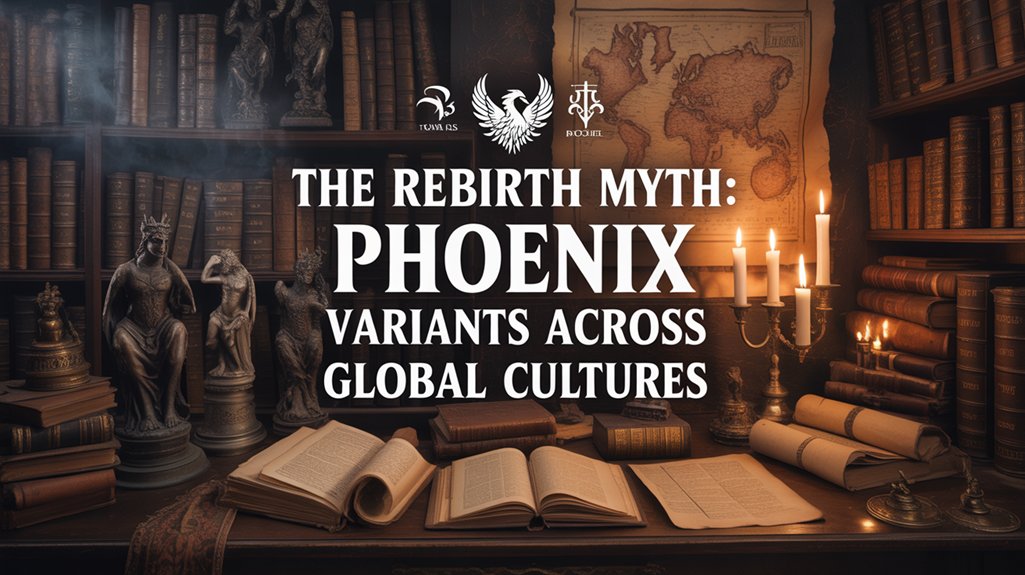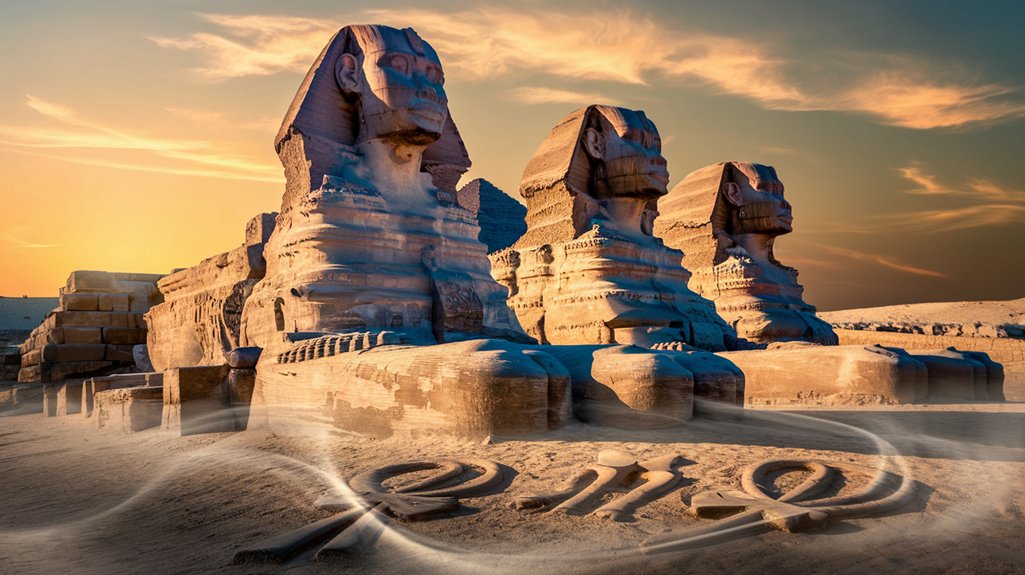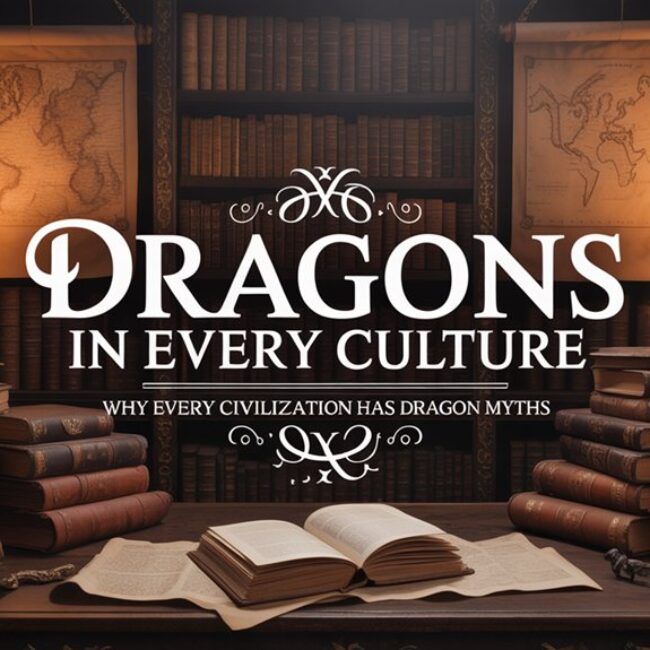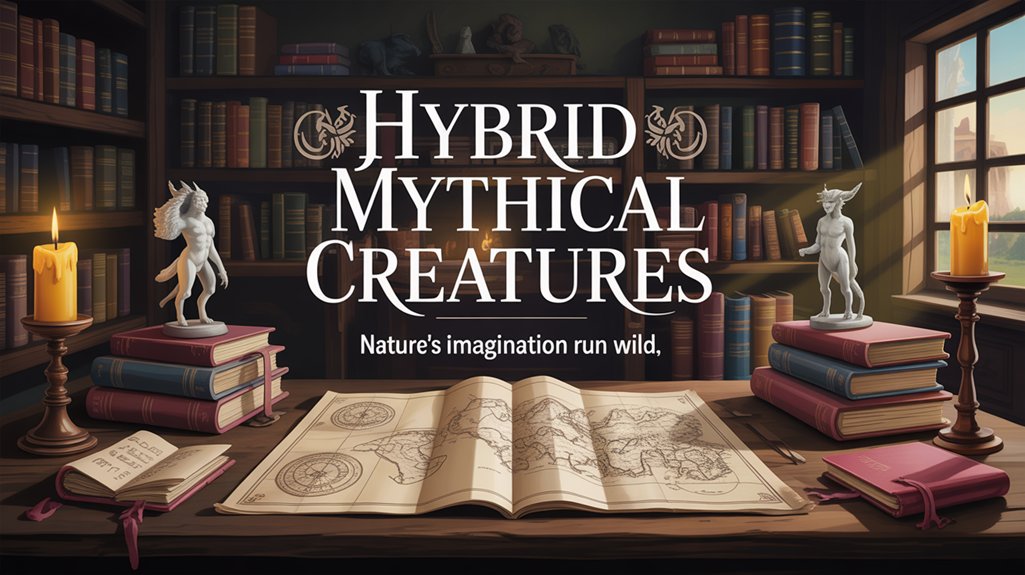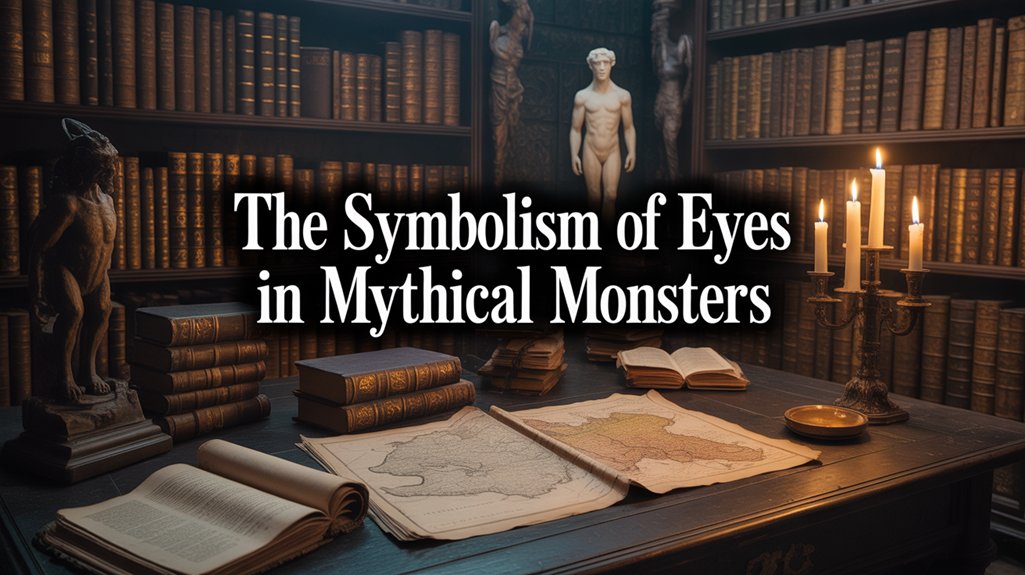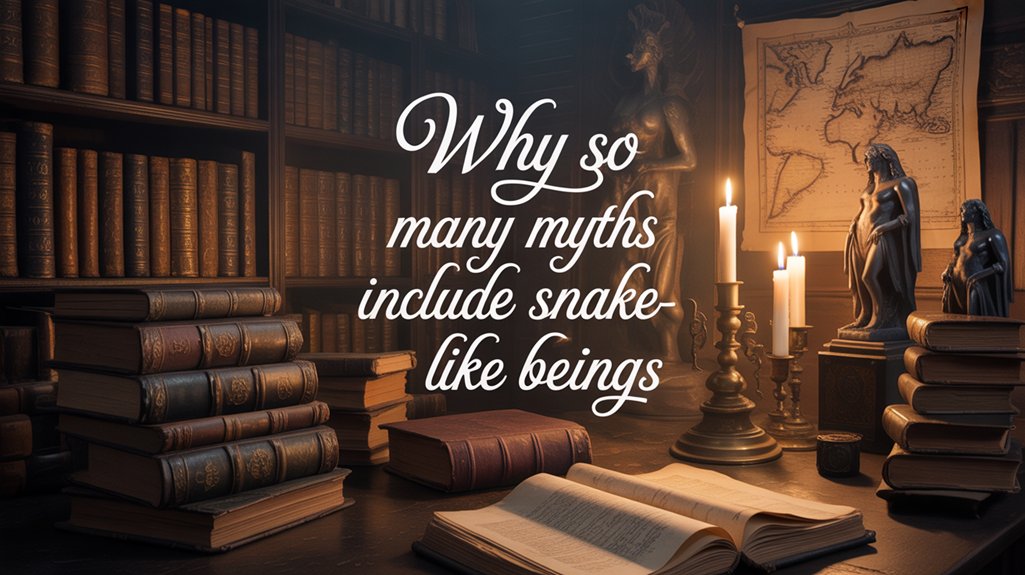
You’ll discover the phoenix archetype emerging independently across civilizations: Egypt’s Bennu rising with Ra’s solar regeneration at Heliopolis, Greece’s self-immolating phoenix orchestrating quincentennial resurrection through aromatic flames, China’s Fenghuang embodying yin-yang equilibrium without destruction, and Slavic folklore’s luminous Zhar-Ptitsa representing transformative pursuit. These convergent mythologies reveal humanity’s collective unconscious grasping identical truths about cyclical renewal, ego-death, and post-traumatic evolution—from ancient papyrus inscriptions to contemporary psychological frameworks where catastrophe becomes sacred catalyst, each culture independently recognizing that true resilience emerges through voluntary destruction and chimeric rebirth, a persistent flame illuminating deeper patterns awaiting your exploration.
Table of Contents
ToggleKey Takeaways
- Multiple civilizations independently created immortal bird myths symbolizing death and resurrection, including Egypt’s Bennu, Greece’s phoenix, Persia’s Simurgh, and China’s Fenghuang.
- Egypt’s Bennu represented solar regeneration and Nile flooding cycles, while Greece’s phoenix orchestrated self-immolation and rebirth every five centuries.
- China’s Fenghuang symbolizes cosmic equilibrium and harmony rather than death-rebirth cycles, representing peace and feminine virtues in dynastic culture.
- The Slavic Firebird represents transformative pursuit and freedom, where the quest itself holds more significance than capturing the elusive creature.
- Modern interpretations include Harry Potter’s Fawkes and Jungian psychology’s use of phoenix symbolism to represent ego-death and post-traumatic growth.
Immortal Bird Across Civilizations
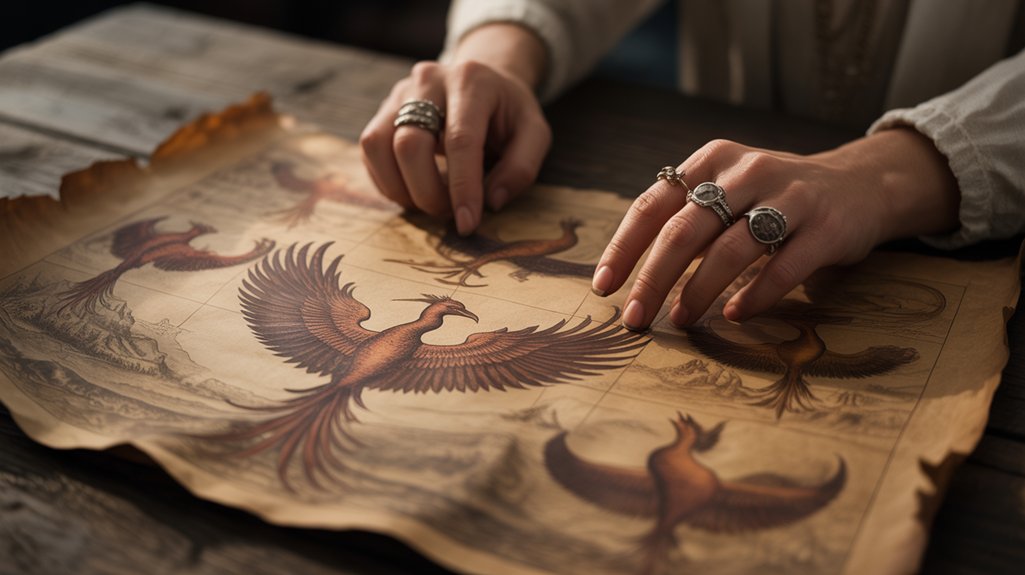
Although separated by vast oceans and millennia of divergent cultural evolution, civilizations across the ancient world independently conceived of an immortal bird—a creature whose essence surpassed mere mortality through cycles of death and resurrection.
Across continents and centuries, humanity independently envisioned the same eternal truth: immortality achieved through perpetual death and resurrection.
You’ll find Egypt’s Bennu rising with solar precision, its golden plumage mirroring Ra’s eternal journey. Greece offered you the phoenix proper: five centuries of existence culminating in aromatic self-immolation, rebirth emerging from cinders.
Persia’s Simurgh carried eldritch wisdom and healing powers through its immortal wings. China’s Fenghuang embodied cosmic equilibrium—virtue made manifest in feathers, yin balancing yang’s fire. Japan’s Hō-ō descended bearing peace. Russia’s Zhar-Ptitsa blazed with chimeric magic through frozen forests.
These cultural interpretations reveal humanity’s universal recognition of cyclical renewal, each tradition encoding its mythological significance through distinct symbolic frameworks.
You’re witnessing convergent mythology—separate peoples reaching identical truths about alteration, immortality, transcendence. The pattern repeats. Death becomes doorway. Flame becomes cradle. In Christian tradition, the phoenix became a powerful symbol of Christ’s death and resurrection, its self-renewal mirroring theological concepts of eternal life and spiritual rebirth.
##
You’ll discover that the phoenix archetype manifests across civilizations as a chimeric constellation of sacred avians, each culture weaving its own threads of resurrection and cosmic fire into the tapestry of immortality.
From the Bennu bird rising with Ra’s solar barque over the Nile’s primordial waters to the Fenghuang’s graceful descent upon Chinese imperial courts, these eldritch creatures transcend mere mythology—they’re living repositories of humanity’s oldest yearning for renewal.
The Greco-Roman phoenix and Slavic firebird complete this quaternary of flame-born entities, each bearing distinct cultural fingerprints yet sharing that ineffable essence: death altered into beginning.
Ancient Egyptian Bennu Bird
Upon the primordial shores of the Nile, where civilization first etched its sacred geometries into stone, the Bennu bird emerged from Egyptian cosmology as a creature of perpetual resurrection—a heron-shaped deity whose luminous feathers caught the first rays of Ra’s solar barque.
You’ll discover that Bennu mythology centered in Heliopolis, where priests recognized this eldritch messenger as embodiment of Egyptian resurrection itself. Each dawn witnessed its renewal. Each flood season mirrored its regenerative power, altering barren silt into fertile promise. The cycle never ceased.
Death meant nothing to this chimeric being who transcended temporal boundaries, its existence woven into the very fabric of ma’at—cosmic order demanding perpetual return. Here stands freedom’s ultimate expression: consciousness unbound by mortality’s constraints, eternally self-creating. This transformation narrative finds its later echo in Ovid’s Metamorphoses, where the Roman poet explored similar themes of death and rebirth through mythological change.
Greek and Roman Traditions
When Herodotus chronicled the phoenix in his *Histories* circa 440 BCE, he transmitted Egypt’s Bennu into Hellenic consciousness as a creature bound to quincentennial cycles—five hundred years of existence culminating in self-immolation upon a pyre of cassia and frankincense.
Greek symbolism embraced this eldritch avian as immortality incarnate, a chimeric proof to renewal’s inexorable power.
You’ll find Ovid’s *Metamorphoses* altering the narrative further, weaving Roman adaptations that positioned the phoenix as empire’s eternal mirror—Rome itself rising perpetually from conquest’s ashes.
Early Christian theologians seized upon this cyclical resurrection, recognizing in the bird’s fiery rebirth a prefiguration of Christ ascending from death’s dominion.
The phoenix became liberation’s avatar, proof that chains—whether mortal, political, or spiritual—could never constrain transformation’s sacred flame.
Chinese Fenghuang Symbolism
Celestial dichotomy manifests in the Fenghuang’s resplendent form—this immortal creature dwelling not in fire’s altering crucible but in equilibrium’s sacred domain, where yin’s receptive darkness interweaves with yang’s assertive light.
You’ll find Fenghuang symbolism diverging sharply from Western phoenix mythology, embodying peace rather than conflagration. Its chimeric anatomy—rooster’s crown, swallow’s beak, peacock’s cascading plumes—emerges in artistic representations as harmonious union made manifest.
The empress claims this eldritch being as her sovereign emblem, channeling feminine virtues through its graceful bearing. Cultural significance permeates dynastic China, where wedding motifs invoke the Fenghuang paired with dragons, masculine and feminine energies locked in eternal dance.
These mythical narratives promise prosperity, stability. Freedom through balance. Yin yang principles transcend mere philosophy here—they breathe, they soar, they consecrate unions between mortal souls seeking cosmic harmony.
Slavic Firebird Folklore
Through birch forests and snow-laden steppes, the Zhar-Ptitsa blazes—a creature whose aureate feathers illuminate Slavic consciousness with paradoxical fire.
You’ll find this eldritch avian embodies freedom’s double edge: luminous plumage promises change, yet pursuit chains you to obsessive desire. Firebird symbolism transcends mere beauty—each feather burns with consequence, blessing and curse intertwined.
Heroic quests begin where rationality ends. The bird’s elusiveness challenges your worthiness, demanding sacrifice across supernatural thresholds. You can’t simply possess such radiance; you must earn transformation through trials that strip away pretense, revealing authentic self beneath ambition’s veneer.
Stravinsky understood this chimeric essence, translating folkloric wisdom into orchestral fire.
The Firebird remains forever ungraspable, forever beckoning—a reflection of Slavic understanding that true freedom exists not in capture, but in transformative pursuit itself.
Ancient Egyptian Bennu Bird

You’ll find the Bennu bird’s earliest attestations within the Heliopolitan Sacred Bird Texts, those enigmatic hieroglyphic inscriptions that emerged from Heliopolis—ancient Iwnw, the City of the Sun—where priests chronicled this heron-crowned entity’s eldritch connection to Ra’s daily resurrection.
The Nile Delta Creation Center wasn’t merely a geographical location but a cosmological nexus, a liminal threshold where primordial waters met divine flame, and where the Bennu perched upon the sacred benben stone at creation’s first dawn.
This creature’s essence remains inseparable from the Solar Cycle Resurrection Connection: each sunrise mirrored the soul’s potential for change, each flood season echoed eternity’s promise, each feathered ascent toward the celestial disk mapped the deceased’s journey through Duat’s shadowed corridors toward immortal radiance.
Heliopolitan Sacred Bird Texts
In the temple precincts of Heliopolis, where priests of the Old Kingdom (circa 2686–2181 BCE) conducted their solar liturgies at dawn, the Bennu bird emerged from sacred texts as something far more eldritch than mere avian symbol—it was cosmogonic force itself, the self-generated entity that perched upon the primordial mound when chaos gave way to order.
You’ll find within these Heliopolitan rituals a creature described as rising from its own ashes each morning, mirroring Ra’s resurrection across the eastern horizon. The sacred symbolism wove together solar regeneration with the Nile’s annual inundation—both life-giving cycles that converted death into abundance.
These papyri and temple inscriptions didn’t simply record mythology; they preserved operational cosmology, instruction manuals for maintaining universal order through reverent acknowledgment of the Bennu’s eternal return.
Nile Delta Creation Center
| Sacred Element | Cosmological Function |
|---|---|
| Benben Stone | First land, Ra’s perch |
| Morning Cry | Reality’s boundary marker |
| Radiant Plumage | Divine order manifest |
You’ll find here no chimeric embellishment. Only alteration’s first template. Death preceding genesis.
Solar Cycle Resurrection Connection
Beyond Heliopolis’s sacred precincts where the Benben Stone marked reality’s first emergence, the Bennu’s significance deepened through its inextricable bond with solar resurrection—that eternal return of Ra across heaven’s vault.
You’ll find this heron-crowned entity embodied something primal: dawn’s guarantee. Each morning witnessed its renewal alongside the sun’s ascent, altering abstract solar cycles into visceral promise.
The bird’s radiant plumage mirrored celestial fire itself, burning away death’s shadow. Here was eternal renewal made flesh and feather, a living covenant between heaven and the Nile’s fertile earth.
You’re witnessing more than mythology; you’re encountering humanity’s defiance against oblivion, that ancient refusal to accept finality.
The Bennu didn’t simply represent resurrection. It enacted it, daily, defiantly, eternally—freedom from mortality’s tyranny.
Greek Phoenix Self-Immolation Ritual

When death approaches after half a millennium of existence, the Greek phoenix doesn’t surrender to entropy—it orchestrates its own apocalyptic alteration.
You’ll witness the creature gathering aromatic wood—cinnamon, frankincense, myrrh—constructing a funeral pyre that doubles as birthing chamber. The self immolation significance transcends mere destruction; it’s alchemical purification through flame, where consciousness chooses annihilation to achieve transcendence. Herodotus chronicled this eldritch ritual, documenting how priests transported the predecessor’s remains to Helios’s temple, honoring what was before celebrating what emerges.
| Ritual Phase | Duration | Symbolic Meaning |
|---|---|---|
| Nest Construction | Final days | Preparation, sovereignty over fate |
| Combustion | Single moment | Purification, alteration |
| Resurrection | Instantaneous | Renewal, cyclical eternity |
Phoenix symbolism embodies resilience through voluntary destruction—you’ll recognize this chimeric paradox where death births life. The flames consume everything temporal, leaving only essence. From ash-scattered potential springs the reborn, proving that sovereignty over one’s ending grants mastery over new beginnings.
Cyclical Renewal and Transformation Themes
The phoenix’s self-orchestrated immolation represents merely one moment in an eternal recurrence—what follows extends beyond singular resurrection into profound cosmological architecture.
You’ll discover that cultural symbolism across civilizations reveals mythological parallels transcending geographical boundaries, each tradition encoding liberation through perpetual change.
The cyclical nature manifests through distinct yet interconnected visions:
- Egyptian Bennu: Solar alignment with Ra’s daily journey, tied to Nile’s flooding—annual deliverance from drought’s tyranny
- Greek Phoenix: Five-century intervals marking cosmic time, self-sovereignty through controlled destruction
- Chinese Fenghuang: Yin-yang synthesis embodying freedom from dualistic imprisonment, harmonic balance as ultimate emancipation
- Persian Simurgh: Eldritch wisdom transmitted through death’s dissolution, healing knowledge born from ash
These chimeric entities don’t merely survive death. They weaponize it.
Each variant demonstrates that genuine liberation requires voluntary disintegration—the courage to release obsolete forms.
You’re witnessing humanity’s ancient understanding that stagnation equals captivity, while change, however devastating, guarantees autonomy.
Harry Potter’s Fawkes the Phoenix
Within Rowling’s wizarding cosmology, you encounter Fawkes as the phoenix archetype distilled into corporeal magic—a creature whose crimson plumage burns with eldritch luminescence while his tears transfigure venom into harmless essence, manifesting the ancient healing properties attributed to phoenixes across Mediterranean and Near Eastern traditions.
His unwavering devotion to Dumbledore’s philosophical resistance against darkness echoes the classical phoenix’s role as divine messenger and guardian of cosmic order, a bond that transcends mere animal companionship to embody sacred covenant.
You witness his most profound alteration in the Chamber of Secrets’ subterranean depths, where his self-immolation and resurrection from ash become not spectacle but sacrament—a ritualistic demonstration of cyclical renewal that grants Harry both physical salvation and spiritual fortitude.
Fawkes’s Healing Tear Powers
Although modern fantasy literature often appropriates ancient symbols without adequate reverence, J.K. Rowling’s depiction of Fawkes’s tears transcends mere fantasy trope—it channels genuine alchemical wisdom.
These crystalline droplets possess healing properties that operate beyond conventional magic, neutralizing basilisk venom’s eldritch corruption through catalytic alteration.
You’ll recognize how Rowling weaves medieval phoenix lore into Harry’s salvation: Fawkes weeps over mortal wounds, his tears restoring cellular integrity, purging necrotic enchantments.
This isn’t whimsical invention—it mirrors Renaissance grimoires describing phoenix essence as the ultimate panacea, the philosopher’s stone made liquid.
The bond between wizard and phoenix creates what ancient texts called *sympathia magica*, where loyalty itself becomes transformative power.
Fawkes embodies chimeric healing—part corporeal medicine, part spiritual renewal—demonstrating how mythological creatures preserve primordial knowledge about regeneration’s sacred mechanics.
Loyalty to Dumbledore’s Cause
When Fawkes materializes through flame in the Chamber of Secrets, bearing the Sorting Hat to Harry’s desperate hands, you witness loyalty transcending mere servitude—this becomes *fidelitas absoluta*, the unbreakable covenant between phoenix and wizard-guardian.
Fawkes’ loyalty manifests through calculated intervention: delivering the Sword of Gryffindor, weeping healing tears onto basilisk venom, carrying the wounded to safety. This isn’t the chimeric obedience of enchanted creatures but conscious dedication to Dumbledore’s legacy of resisting tyranny.
The phoenix answers no master’s call through magical compulsion; he chooses his cause. When Dumbledore falls, Fawkes departs Hogwarts forever, his eldritch song echoing through stone corridors—a final lament.
You understand then: true loyalty dies with its recipient, refusing transference. The bond can’t be inherited.
Rebirth in Chamber Scene
As basilisk venom courses through Harry’s veins—black poison spreading from punctured flesh—Fawkes descends in a cascade of crimson flame, settling beside the dying boy with otherworldly precision.
This chamber significance transcends mere narrative drama; you’re witnessing rebirth symbolism enacted through alchemical alteration. The phoenix’s tears don’t simply heal—they transmute death into renewal, dissolving necrotic tissue with eldritch luminescence.
Here, beneath Hogwarts’ foundations, the ancient cycle manifests: dissolution precedes resurrection. Fawkes embodies what you’ve always sensed about mortality’s impermanence—that endings contain beginnings, that flame purifies rather than destroys.
The subterranean setting amplifies this archetypal pattern, positioning Harry’s salvation within earth’s womb-like depths. No institutional authority orchestrates this moment. Only primordial forces, working through feather and tear, asserting life’s stubborn continuance against extinction’s certainty.
X-Men’s Jean Grey Transformation
Within the illuminated pages of Marvel Comics’ 1976 “Uncanny X-Men” series, Jean Grey’s metamorphosis into the Phoenix crystallizes a distinctly modern interpretation of the resurrection myth—one where cosmic consciousness merges with human vulnerability to forge something altogether chimeric.
Jean’s sacrifice to save her teammates becomes the threshold moment, the death-that-births-alteration echoing across millennia of phoenix narratives.
You witness Phoenix duality manifest through her oscillation between beneficent creator and apocalyptic destroyer, the eldritch power corrupting her into Dark Phoenix:
- Telepathic omniscience granted by the Force mirrors divine knowledge traditionally reserved for resurrected deities
- Molecular manipulation represents the alchemical alteration central to rebirth mythologies
- Self-immolation to prevent further devastation recapitulates the phoenix’s cyclical death
- Identity fragmentation reflects shamanic dismemberment preceding spiritual renewal
This narrative architecture demonstrates how ancient rebirth patterns infiltrate contemporary mythology, translating cosmic resurrection into psychological terrain where inner darkness demands integration rather than suppression.
Phoenix Archetype in Jungian Psychology
Carl Jung’s analytical framework modifies the phoenix from mere mythological curiosity into psychological cartography—a map charting the treacherous territories where ego-death precedes individuation.
Within this Jungian alteration, you encounter the archetypal significance of flames consuming old identities, making space for psychological rebirth. The phoenix emerges as resilience symbolism incarnate, dwelling in the collective unconscious as universal memory—every culture recognizing this eldritch pattern of dissolution and renewal.
When you dream of conflagration and emergence, dream analysis reveals creative potential awakening from dormant chambers within your psyche. The phoenix represents personal evolution itself: altering crises become sacred opportunities rather than catastrophic endings. This mythological interpretation transcends mere academic exercise.
Through therapeutic integration, practitioners guide you toward embracing your own chimeric nature—part destruction, part creation.
You’re not broken when life reduces you to ashes. You’re preparing for metamorphosis. The self reconstructs itself, phoenix-like, demonstrating that endings contain beginnings, that death fertilizes rebirth, that your struggles forge wings.
Modern Resilience and Recovery Metaphors
Through contemporary trauma narratives and recovery literature, the phoenix surpasses its ancient mythological origins to become the preeminent symbol of post-traumatic growth—that paradoxical flowering of strength from catastrophic wounds.
You’ll find this eldritch archetype woven throughout modern self-help movements, where resilience strategies emerge not as mere platitudes but as sacred methodologies for alchemical alteration.
Consider Fawkes—Rowling’s crimson guardian—whose loyalty and cyclical rebirth mirror your own transformative journeys through devastation’s crucible.
Fawkes embodies cyclical transformation—his rebirth from flame mirrors humanity’s capacity to rise renewed from catastrophic wounds.
Psychology codifies what ancients intuited: catastrophe births chimeric possibilities. You’re witnessing trauma’s conversion into wisdom, pain transmuted into ineffable strength.
This isn’t passive recovery. It’s active resurrection.
Contemporary artists tattoo phoenix flames onto skin, marking survival with indelible testimony. You’re claiming your narrative, declaring that endings catalyze genesis rather than annihilation.
The phoenix becomes your mirror—reflecting humanity’s capacity to metabolize suffering into luminous renewal, to embrace change as liberation rather than loss, to recognize that from ash emerges unprecedented freedom.
Global Symbol of Hope
Beyond individual metamorphosis, the phoenix transcends personal narrative to inhabit collective consciousness—a luminous thread binding disparate civilizations across millennia.
You encounter this archetype’s cultural interpretations radiating from Egypt’s Bennu, aligned with Ra’s solar authority, cycling through death and dawn. The Greek iteration burned through five centuries before its eldritch conflagration birthed resurrection—symbolic meanings early Christians recognized instantly, mapping Christ’s triumph onto those consecrated ashes.
In Chinese cosmology, the Fenghuang doesn’t immolate but changes, its chimeric form balancing yin and yang, heralding prosperity through harmony rather than destruction.
From Dante’s medieval verses to Rowling’s contemporary wizardry, you trace this creature’s persistent flame. Each culture refracts hope through its own prismatic lens, yet the core remains incandescent: adversity yields renewal.
The phoenix doesn’t merely survive—it *becomes*, transmuting suffering into transcendence. You recognize humanity’s shared yearning encoded within these wings.
Frequently Asked Questions
What Is the Average Lifespan of a Phoenix Before Self-Immolation?
You’ll find the phoenix’s mythical lifespan varies dramatically across traditions—from 500 years in Herodotus’s fifth-century BCE accounts to 1,461 years in Egyptian solar calculations.
The rebirth cycle isn’t predetermined; rather, you witness the creature sensing its own mortality through eldritch intuition.
Chinese *fenghuang* traditions suggest cycles spanning millennia. No fixed timeline binds this chimeric entity.
Its self-immolation emerges when ancient wisdom dictates renewal, liberating itself from temporal constraints through flames.
Are There Phoenix Variants in Indigenous Australian or Native American Mythologies?
You’ll find the *Australian Firebird* concept isn’t traditionally documented in Aboriginal Dreamtime narratives, though fire-transformation motifs exist independently.
Among *Native American Resurrection* traditions, you’ll discover the Thunderbird embodies cyclical renewal—eldritch power manifesting through storm and lightning rather than self-immolation.
The Hopi’s Kachina spirits and certain Pacific Northwest totemic beings carry regenerative essence, yet they’re chimeric entities distinct from phoenix archetypes.
True cyclical death-rebirth through flame remains mainly Mediterranean, Persian, and East Asian in origin.
How Do Buddhist and Hindu Rebirth Concepts Differ From Phoenix Mythology?
Unlike the phoenix’s singular, eldritch flame-death, you’ll find Buddhist and Hindu rebirth cycles emphasize spiritual evolution through countless incarnations.
Your consciousness transmigrates—karma-bound, purposeful—across lifetimes seeking moksha or nirvana.
The phoenix resurrects identically; you change progressively.
Where the firebird embodies cyclical return to sameness, dharmic traditions offer liberation’s promise: transcendence beyond the wheel entirely.
One creature burns eternally.
You journey toward freedom from rebirth itself—chimeric souls evolving through samsara’s cosmic spiral.
Which Cultures Associated the Phoenix With Specific Gemstones or Precious Materials?
Imagine flames crystallizing into eternal jewels—you’ll find Egyptian texts linking the phoenix to precious materials like frankincense and myrrh, altering resins burned as offerings.
Chinese traditions adorned the Fenghuang with jade, that eldritch stone of immortality.
Gemstone symbolism permeates Arabian phoenix lore, where the bird’s nest contained cinnamon, aromatic gums, and pearls—each material embodying incorruptibility.
You’re witnessing how ancient cultures encoded liberation through imperishable substances, their phoenix rising adorned with earth’s most enduring treasures, symbols of your own unshackled alteration.
Did Medieval Alchemists Use Phoenix Symbolism in Their Transformation Experiments?
You’ll find medieval alchemists profoundly embraced phoenix alchemy symbolism throughout their conversion processes.
The bird’s death-and-resurrection cycle mirrored the *nigredo*, *albedo*, and *rubedo* stages—blackening, whitening, reddening—essential to transmuting base metals into gold.
They inscribed phoenix emblems in manuscripts like the *Rosarium Philosophorum* (1550), understanding its sacred flames represented *calcinatio*, the purifying fire that destroys imperfect matter.
This wasn’t mere metaphor; alchemists believed the phoenix embodied actual spiritual-material conversion, the *opus magnum* itself.
Conclusion
You’ve traversed the immolated ash-realms of countless civilizations, witnessed the Bennu’s solar resurrection, traced Jean Grey’s chimeric alteration through fire. Now you understand: the phoenix isn’t merely archetype or eldritch symbol—it’s your own cyclical becoming. Each descent demands conflagration. Each ending births luminescence. You carry this ancient knowledge forward, embodying transformation’s sacred geometry. When darkness threatens to consume you, remember: you’ve always possessed the incandescent power to rise, transcendent and reborn.

